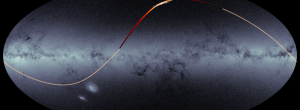A Stellar Stream in the Milky Way Provides Evidence of Dark Substructure
Scientists at the Center for Astrophysics | Harvard & Smithsonian have observed what may be evidence of dark matter interfering with a stellar stream in the Milky Way galaxy.

For scientists and non-scientists alike, the discovery tells an exciting, edge-of-your-seat story. “We know that 90% of the mass in our universe is invisible. We don’t know what it is, but we’re curious,” said Dr. Ana Bonaca, ITC Fellow at the CfA and lead author of the study. “Stellar streams, which are what we’re studying here, tell us the story of our galaxy. They are so long and thin that they are sensitive to the tiniest disturbances as they orbit through the galaxy. Our findings are that…in action.”
Gaia, a mission of the European Space Agency (ESA), had a second data release in April 2018, which provided the basis for a new study of GD-1, the longest and most visible thin stellar stream in the Milky Way. Typically, stars are distributed close to uniformly along such streams, so scientists immediately noticed that some of the stars in the GD-1 stream were not behaving as expected.
“Stellar streams were thought to be more or less smooth in appearance, but GD-1 has gaps or regions of lower density along the stream. Close to one of these gaps there is an offshoot of misaligned stars,” said Adrian Price-Whelan, a coauthor of the study. “So first, we found something interesting that didn’t match what we expected to see, thanks to Gaia.”
Stellar streams are associations of stars that once previously belonged to a dwarf galaxy or a globular cluster, but that were pulled out by the Milky Way’s tidal forces and stretched out into streams. In the standard picture, these streams are long, thin, and regular. The observed behavior in GD-1, however, could not be explained by tidal forces alone. Instead, Bonaca and collaborators used numerical simulations to show that the observed gap and spur features could be the result of the stream encountering a dense, massive object.
“We considered a number of different objects as potential sources of perturbation, but none of them seemed to fit. We looked at the orbits of all known satellites in the Galaxy, but none crossed paths with GD-1 recently. We also considered whether molecular clouds could have done the damage because GD-1 crosses the Milky Way disk, but found they are not dense enough,” said Bonaca. “There is no obvious culprit.”
With no known culprits, scientists have turned to more exotic explanations, and that’s big news for dark matter theorists. “One of the fundamental predictions of the dark-matter model is that there ought to be many concentrations or clusters of dark matter orbiting in the outskirts of our Galaxy. This stream looks like it can be used to find those small clumps of dark matter,” said David Hogg, a coauthor of the study. “Ruling out all other possibilities and actually detecting a small clump of dark matter would be a huge clue for understanding the nature of this important component of the Universe.”
While Gaia data was used to make initial observations, the team has since conducted follow-up observations with Hectochelle—a multi-object echelle spectrograph—at the MMT Observatory, located at the Fred Lawrence Whipple Observatory at Mt. Hopkins in Arizona. These new data will help in locating the dark substructure. In addition, Bonaca and other scientists have begun observing other stellar streams with unusual features.
“When something passes close to a stellar stream, it leaves evidence behind, and we can see that something happened there. Even if it’s dark matter. Even if it’s invisible,” said Bonaca. “And if it is a clump of dark matter, there should be many of them. So we’re setting out to search for such oddities in other streams to find out for sure.”
Source: Center for Astrophysics
- 246 reads
Human Rights
Ringing FOWPAL’s Peace Bell for the World:Nobel Peace Prize Laureates’ Visions and Actions

Protecting the World’s Cultural Diversity for a Sustainable Future

The Peace Bell Resonates at the 27th Eurasian Economic Summit

Declaration of World Day of the Power of Hope Endorsed by People in 158 Nations

Puppet Show I International Friendship Day 2020

